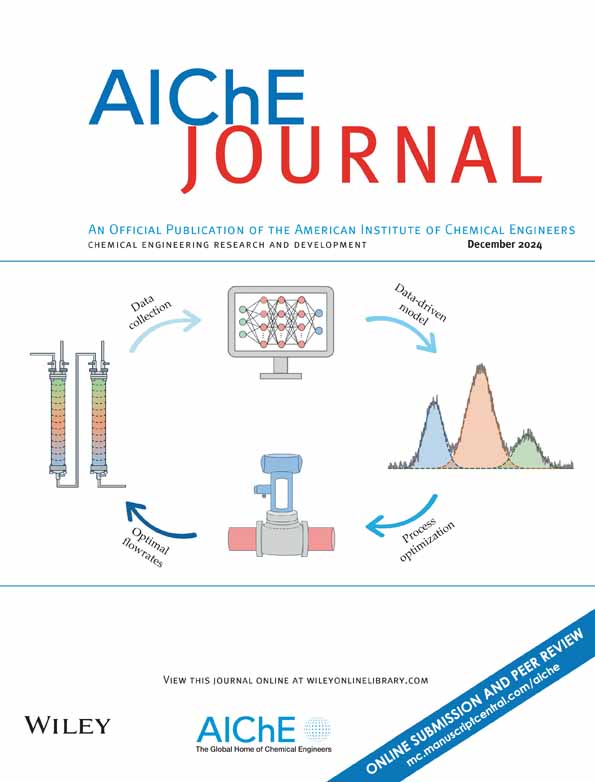Selective hydrodeoxygenation of lignin to 4-ethylcyclohexanol catalyzed by Cu–Ni/MgCrOx spinel
IF 3.5
3区 工程技术
Q2 ENGINEERING, CHEMICAL
引用次数: 0
Abstract
A novel approach is proposed for producing 4-ethylcyclohexanol, a versatile petrochemical in the polymer industry, from the renewable lignin in the presence of Cu–Ni/MgCrOx spinel catalysts. Under the synergistic effect between the Ni0, Cu,+ and the balanced acidic and basic properties of MgO and MgCr2O4, an exceptional yield of monomer (30.1 wt%) with 59.5% selectivity of 4-ethylcyclohexanol (yield of 17.9 wt%) was achieved when the depolymerization of bamboo lignin was performed with Cu6Ni20/MgCr0.5Ox (Cr:Mg = 0.5). Catalyst characterization illustrated that the formation of MgCr2O4 spinel, which restrained the generation of NiMgO2 solid solution and increased the concentration of Ni0 species, along with the surface electron effect between Ni0 and Cu+, contributes to this superior hydrodeoxygenation performance of lignin. Mechanistic investigation further demonstrated that the conversion of lignin to 4-ethylcyclohexanol involves a tandem process of Cβ–O bonds cleavage, demethoxylation, and saturated hydrogenation. Therefore, this work provides new insights on lignin utilization.Cu-Ni /MgCrOx尖晶石催化木质素选择性加氢脱氧制4-乙基环己醇
提出了一种在Cu-Ni /MgCrOx尖晶石催化剂存在下,以可再生木质素为原料制备4-乙基环己醇的新方法。采用Cu6Ni20/MgCr0.5Ox (Cr:Mg = 0.5)对竹木质素进行解聚,在Ni0、Cu、+和MgO、MgCr2O4酸碱平衡的协同作用下,单体收率达到30.1 wt%, 4-乙基环己醇选择性达到59.5% (17.9 wt%)。催化剂表征表明,MgCr2O4尖晶石的形成抑制了NiMgO2固溶体的生成,增加了Ni0的浓度,以及Ni0和Cu+之间的表面电子效应是木质素具有优异的加氢脱氧性能的原因。机理研究进一步表明,木质素转化为4-乙基环己醇涉及c - β - o键断裂、脱甲氧基化和饱和加氢的连续过程。因此,本研究为木质素的利用提供了新的思路。
本文章由计算机程序翻译,如有差异,请以英文原文为准。
求助全文
约1分钟内获得全文
求助全文
来源期刊

AIChE Journal
工程技术-工程:化工
CiteScore
7.10
自引率
10.80%
发文量
411
审稿时长
3.6 months
期刊介绍:
The AIChE Journal is the premier research monthly in chemical engineering and related fields. This peer-reviewed and broad-based journal reports on the most important and latest technological advances in core areas of chemical engineering as well as in other relevant engineering disciplines. To keep abreast with the progressive outlook of the profession, the Journal has been expanding the scope of its editorial contents to include such fast developing areas as biotechnology, electrochemical engineering, and environmental engineering.
The AIChE Journal is indeed the global communications vehicle for the world-renowned researchers to exchange top-notch research findings with one another. Subscribing to the AIChE Journal is like having immediate access to nine topical journals in the field.
Articles are categorized according to the following topical areas:
Biomolecular Engineering, Bioengineering, Biochemicals, Biofuels, and Food
Inorganic Materials: Synthesis and Processing
Particle Technology and Fluidization
Process Systems Engineering
Reaction Engineering, Kinetics and Catalysis
Separations: Materials, Devices and Processes
Soft Materials: Synthesis, Processing and Products
Thermodynamics and Molecular-Scale Phenomena
Transport Phenomena and Fluid Mechanics.
 求助内容:
求助内容: 应助结果提醒方式:
应助结果提醒方式:


